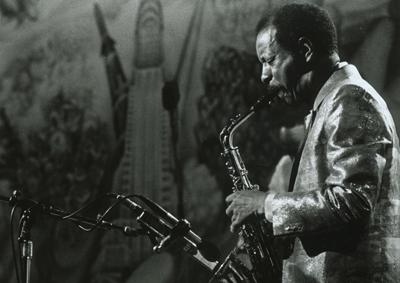Read UCLA Today's article on director Shirley Clarke — "Archive Rekindles Interest in Once-Marginalized Filmmaker"
"..a funky, nonfiction tribute to the great avant-garde saxophonist Ornette Coleman that upends the staid portrait-of-the-artist formula" — Village Voice
“...The collaboration between filmmaker and subject has its own kind of harmony” — New York Times
Ornette: Made in America (1985)
Directed by Shirley Clarke
Nearly thirty years after its initial release, Ornette: Made in America can now be fully appreciated on its own terms, beyond the extraordinary interaction of two visionaries. Upon its release in 1985, Shirley Clarke’s experimentation with practically every conceivable aspect of cinema at times overwhelmed viewers struggling merely to keep up with her subject, Ornette Coleman’s thoroughly demanding re-invention of music.
At the time of release, the two artists’ careers were on opposing trajectories. Clarke had seen her greatest success in the 1960s with a remarkable trio of features, The Connection (1961), The Cool World (1964), and Portrait of Jason (1967). Her subsequent career, as one of the earliest experimental video pioneers was remarkable, but received far more limited acclaim. Ornette was to be her last major piece. Coleman, an underground legend since his controversial 1959 NY appearances at the Five Spot, had long been deemed a pariah. This status is hard to exaggerate. He had literally been beaten and had his saxophone smashed in his early career in Los Angeles. But as critic John Rockwell notes in the film, his work “got him branded him as an eccentric when he was young; it gets him branded as a genius when he’s old.” By 1985, Coleman was collaboratively touring with Pat Metheny on their Song X project, and getting the key to his native city of Fort Worth, Texas (as documented by Clarke), all without compromising in the slightest. He retains his completely unique vision to this day, undeterred by mainstream acceptance, and reiterating his importance as a living part of jazz history.
Clarke’s formal innovation in Ornette, involving the integration of a myriad of techniques and formats, has often been compared to Coleman’s sonic experimentation. His concept of Harmolodics, in which all the various components of music--harmony, melody, rhythm, timbre, time—carry equal weight, indeed has some corollary in Clarke’s polyphonic construction of Ornette. But the comparison does full justice to neither, for Clarke’s work is as filmic as Coleman’s is musical, and each is uniquely their own. Her voice intermingles with his, even as they remain singular; the epitome of what Coleman called unisons, working in concert. The film thus represents both but a whole beyond either—at once dense and weightless, beyond emptiness or gravity—and a thoroughly entertaining provocation.
Ross Lipman
Producer: Kathelin Hoffman. Cinematographer: Ed Lachman. Editor: Shirley Clarke. With: Ornette Coleman, Denardo Coleman, Demon Marshall, Eugene Tatum, William S. Burroughs, Jayne Cortez, John Rockwell, George Russell, Charlie Haden. 35mm, color, 85 min.
Preserved in consultation with producer Kathelin Hoffman Gray and cinematographer Ed Lachman from the original 35mm picture and track negatives. Laboratory services by The Stanford Theatre Film Laboratory, Fotokem, Audio Mechanics, NT Picture and Sound.






 Mobile Navigation
Mobile Navigation

